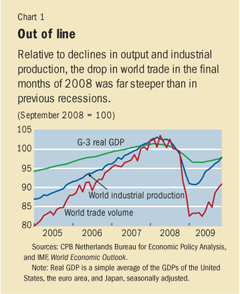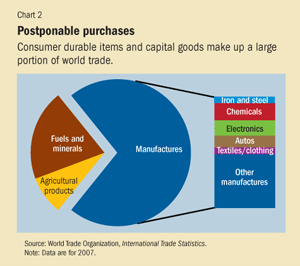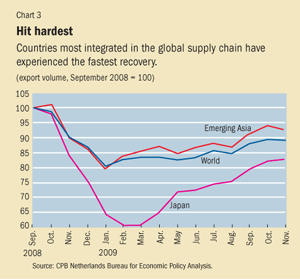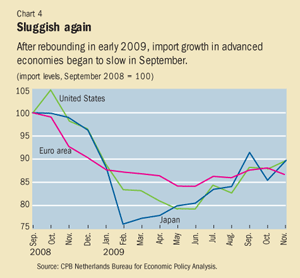Avoiding Protectionism
Finance & Development, March 2010, Volume 47, Number 1
Christian Henn and Brad McDonald
So far the world has resisted widespread resort to trade measures, but the hardest part may be yet to come
RECESSIONS and their aftermath have been breeding grounds for protectionist pressures. When economic output falls and joblessness rises, the notion that somehow foreign trade is at fault is seductive. The temptation grows to export unemployment by blocking imports and subsidizing domestic industries—even though evidence shows that such policies are counterproductive.
The Great Depression of the 1930s spawned serious protectionist actions that exacerbated and extended the economic and social chaos around the world.
The recent global financial crisis is generally considered the worst economic calamity since the 1930s. Financial markets froze. Output plummeted, especially in the advanced economies. World trade shriveled in the final months of 2008. World leaders, though, averred that they had learned the lessons of the Great Depression and vowed to resist protectionist pressures. Have they succeeded? And even if the world has so far withstood the pressure, are these concerns behind us?
The great trade collapse

Trade normally declines more sharply than overall economic activity in a downturn. But the sudden 17 percent contraction in world trade volume between October 2008 and January 2009 initially seemed out of line with a comparatively small decline in inflation-adjusted gross domestic product (GDP) during the same period—which reached 2 percent among major advanced economies (see Chart 1). The severity of the trade collapse does not appear to be the result of any significant resort to protectionism, however. Instead, it appears to be the result of a globally synchronized decline in overall demand that had a particularly strong effect on international commerce because of three major characteristics of trade flows in recent years.

First, trade in durable goods and other postponable purchases—which comprise a disproportionately large share of trade—collapsed most sharply. Financial turmoil led credit markets to seize up. The spike in uncertainty in financial markets caused consumers (already shaken by the loss of wealth in the housing and stock market downturns) to delay purchases of durable items, such as electronic products and cars, on an unprecedented scale. Firms shelved investment plans in response to lower consumer demand and higher capital costs, reducing demand for capital goods. Capital goods and consumer durables make up most of global merchandise trade (see Chart 2)—but a much smaller share of world GDP, which is composed largely of services and nondurables. This asymmetry may explain half or more of the collapse in trade (Levchenko, Lewis, and Tesar, 2009; Baldwin, 2009).
Second, because of extensive global supply chains, components are traded a number of times before the final good is produced.Downturns magnify these supply chain effects: postponable goods have more extensive supply chains, and in a downturn firms curtail their intermediate input orders both to reduce output and to cut inventories (Freund, 2009). Just-in-time production techniques have allowed firms to maintain lower inventories, but they propagate demand shocks more rapidly. This inventory-adjustment role can shed light on the abruptness of the trade collapse in late 2008 and early 2009—after which trade leveled off quickly. Countries most integrated in global supply chains experienced the most abrupt decline in trade. Japan’s exports, for example, contracted by a third over this period.

Third, increased reliance on trade finance may have contributed to trade contraction. Global supply chains mean that firms need longer-term financing for their working capital, given that products take more time to reach the end consumer. And because of these longer supply chains, bank-intermediated trade financing, which creates assurances between importers and exporters, has become more important. At least in the early stages of the crisis, the higher costs and declining availability of trade finance had a negative impact, especially in emerging market economies (Dorsey, 2009).

Trade has begun to recover, but the durability of that recovery is not yet assured. World export volumes increased by about 10 percent between May and November 2009 (see Chart 3). Global supply chains seem to be playing a key role in the rebound: the regions most integrated in these chains, such as east Asia, have experienced the strongest recovery in trade. However, advanced economy imports have slowed down since September (see Chart 4). Sustaining open markets will be especially important to underpin trade and to support a broad-based recovery.
Protectionism appears muted
One factor little apparent in the abrupt contraction in goods and services trade during 2008–09 was protectionism. From almost any perspective, there has been relatively little protectionist activity since the onset of the crisis. The World Trade Organization (WTO) estimates that less than 1 percent of global trade has been subjected to new protectionist measures since the crisis began (WTO, 2009). Although several countries have raised tariffs on some (mostly narrow) product categories, only a few countries have imposed more widespread increases. Many developing countries have eschewed tariff increases despite WTO tariff ceilings that provide ample room for them to raise their applied tariff rates—demonstrating, perhaps, an awareness of the importance of open markets to their own economic performance as well as to global recovery.
Trade measures adopted in response to the crisis may nonetheless have tilted the playing field in some markets. Government bailouts and increased subsidies may have deflected pressure for more damaging measures, but have tended to favor domestic enterprises, particularly in the financial and manufacturing sectors. Expanded government procurement preferences for domestic firms also disadvantaged competitors—and diminished the impact of stimulus measures on global growth. Other subtle responses to the crisis include nontariff barriers such as restrictive import licensing and more cumbersome customs procedures, and the apparent intensification of product standards and regulations. Finally, as trade recovered, industries began to file petitions for antidumping measures at a greater rate in the second half of 2009 (Bown, 2009).
Experience of the 1930s
Policymakers have done well to recall the experience of the Great Depression. In 1929, the U.S. Congress had begun work on a substantial tariff increase even before the stock market crash. The enactment of the Smoot-Hawley Tariff Act in June 1930—despite strong objections from many economists—provoked deep resentment and some retaliation globally. A League of Nations conference convened in 1930 to avert a cycle of protectionism broke down. In 1931 there was an accelerated deterioration in global trade and a “chaotic scramble to protect domestic markets and safeguard the balance of payments” (Eichengreen and Irwin, 2009). Major countries undertook substantial currency devaluations, imposed exchange restrictions, or sharply tightened import tariffs and introduced import quotas. Lacking an independent monetary policy, countries that kept their currencies fixed against gold were more likely to restrict trade, particularly once partner countries devalued their own currencies.
Global trade volume fell by 25 percent between 1929 and 1933, with nearly half of this decline attributable to higher trade barriers. In the United States, the new tariff raised the average rate on dutiable imports from an already high 40 percent to 47 percent. A larger effect, however, came through the interaction of deflation and the use of “specific” tariffs. Irwin (1998) concluded that increases in the effective tariff (both from Smoot-Hawley and deflation) accounted for a 12 to 20 percentage point decline in U.S. imports between 1930 and 1932.
Although protectionism did not cause the Great Depression, higher trade barriers exacerbated it and—most important—worked to choke off recovery. Global output returned to its precrisis levels by 1938, but with a trade-to-GDP ratio some 20 percent below that of 1929. Even though the layers of restrictions were peeled away from 1934 onward, in some cases it took decades to reverse the missteps of 1930–32.
A repeat avoided so far
The recent crisis in its severity could well have ignited a flurry of protectionist measures. There are several reasons it has not.
Atop the political agenda
The heightened awareness of political leaders of the risks of protectionism was evident early in the crisis. Leaders of the Group of 20 (G-20) advanced and emerging economies pledged in November 2008 to “refrain from raising new barriers to investment or to trade in goods and services, imposing new export restrictions, or implementing” measures to stimulate exports that are inconsistent with World Trade Organization (WTO) rules.
In April 2009, G-20 leaders extended this pledge through 2010 and asked the WTO and other institutions to monitor their countries’ adherence to this pledge. This request provided further impetus to continue the activities begun by the WTO in October 2008. WTO monitoring reports have provided critical insight into the nature and extent of trade policy responses to the crisis. The G-20 response has been supplemented by activities undertaken in other international institutions, individual governments, and unofficial entities such as the independent Centre for Economic Policy Research’s Global Trade Alert.
- Economists and policymakers highlighted very early how a resort to protectionism could deepen and prolong the crisis. In particular, the high-level attention by leaders of the Group of 20 advanced and emerging economies and extensive monitoring by the WTO have kept policymakers alert to these risks (see box).
- Multilateral institutions such as the WTO and the IMF have provided transparency and ensured an awareness of the adverse effects of protectionist actions on others. Multilateral rules have established expectations of the types of policy responses considered responsible.
- A strong and early response by governments to boost spending, loosen monetary policy, and prop up the financial sector helped soften and shorten the crisis. Indirect or direct support to businesses may have helped reduce demand for outright protectionism.
- Some 99 percent of import tariffs are now specified in ad valorem, or percentage of value, terms, which means that declining import prices resulted in smaller tariff payments (WTO, 2008). This contrasts with the 1930s, when many tariffs were in specific terms, meaning that when prices of imported goods declined, the tariff as a percentage of value rose.
- Extensive global supply networks and foreign direct investment influence the political economy of trade policy. Domestic firms operating foreign plants or relying extensively on imported inputs have a strong interest in maintaining open trade policies, which helps counterbalance protectionist sentiment.
What the future holds
Although there has so far been less recourse to protectionism than initially feared, pressures remain. Indeed, with unemployment still at its highest levels in years in advanced economies, pressures may even increase in 2010. The costs of a protectionist trap—both as a risk to the recovery and as a drag on global growth for years to come—would be enough to issue the usual call against complacency. But there are additional reasons to be concerned.
Job losses during 2008–09 occurred at a time of declining imports, when trade was contracting much more than overall economic activity. As the market share of imports was falling, foreign-made goods were not typically blamed for job losses. Nor did targeting imports appeal to those concerned with stemming job losses. But, because trade has begun to grow more quickly than has overall activity, the return of imports toward their precrisis market share could stir protectionist demands—particularly where unemployment remains high and in sectors that are slow to recover.
There are other reasons protectionist sentiment may grow. In the past, multilateral or bilateral current account deficits have commonly been used as an argument to restrict trade. Although the recent trade contraction resulted in a narrowing of external imbalances, the extent to which these may reemerge is not yet clear. When fiscal, monetary, and financial sector stimulus measures are withdrawn, affected firms and industries may begin to call for trade protection. Higher commodity prices bring a risk that some countries will impose taxes or restrictions on their commodity exports—a risk that was demonstrated during the 2007–08 food price crisis. Finally, in some emerging markets a surge in capital inflows has brought significant currency appreciation. Regardless of the appropriateness of the new exchange rate, this can strain the competitive position of exporters and of the import-competing domestic sector and generate pressure for import protection and export support.
The folly of protectionism
Further restricting trade would be a poor policy response to the situation the world faces. Moreover, the difficulty in removing measures once they are imposed means protectionist actions taken now could retard economic growth for years. Fortunately, policymakers have recognized the potential for trade measures to interfere with the economic recovery. Too many restrictions may have been imposed, but their application has been relatively narrow. Still, protectionist pressures may intensify in 2010 because unemployment is likely to remain high and imports will bounce back.
In the near future there are three key issues that bear on international trade developments:
Enhanced monitoring of trade policy actions has influenced policy for the better. Clearly identifying discriminatory policies—without overstating their frequency or effects—has been an effective deterrent. There is room for more of this activity.
The possibility of backdoor or “murky” protectionism remains. The risks may materialize not as a customs tariff, but as public procurement policies, product standards, customs procedures, or other actions whose protectionist effects are less transparent.
Concluding the WTO Doha Round of multilateral trade negotiations would help ensure that markets remain open, allowing trade to play its role in the economic recovery and to support strong growth for years to come. Securing tariffs at lower levels, reducing the potential for trade-distorting farm subsidies, enhancing trade policy transparency, and tightening multilateral rules in such trade-related areas as food aid and fishery subsidies would reduce the risk of future trade conflicts and strengthen global economic relations.
References
Baldwin, Richard, ed., 2009, The Great Trade Collapse: Causes, Consequences and Prospects. Available at VoxEU.org
Bown, Chad, 2009, “The Global Resort to Antidumping, Safeguards, and other Trade Remedies amidst the Economic Crisis,” World Bank Policy Research Working Paper WPS5051 (Washington).
Dorsey, Thomas, 2009, “Trade Finance Stumbles,” Finance and Development, Vol. 46, No. 1, pp. 18–19.
Eichengreen, Barry, and Douglas A. Irwin, 2009, “The Slide to Protectionism in the Great Depression: Who Succumbed and Why?” NBER Working Paper 15142 (Cambridge, Massachusetts: National Bureau of Economic Research).
Freund, Caroline, 2009, “The Trade Response to Global Downturns: Historical Evidence,” World Bank Policy Research Working Paper WPS5015 (Washington).
Irwin, Douglas A., 1998, “The Smoot-Hawley Tariff: A Quantitative Assessment,” The Review of Economics and Statistics, Vol. 80, No. 2, pp. 326–34.
Levchenko, Andrei A., Logan Lewis, and Linda L. Tesar, 2009, “The Collapse of International Trade During the 2008–2009 Crisis: In Search of the Smoking Gun,” Gerald R. Ford School of Public Policy Research Seminar in International Economics Discussion Paper 592 (Ann Arbor, Michigan: University of Michigan).
World Trade Organization (WTO), 2008, World Tariff Profiles 2008 (Geneva).
———, 2009, “Overview of Developments in the International Trading Environment” (Geneva, November).


